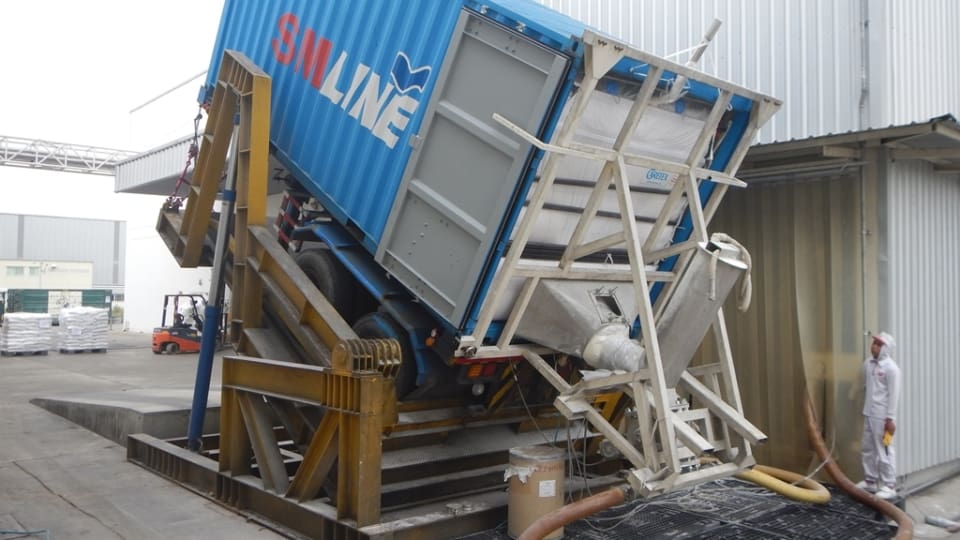Transporting flour products using bulk liners in standard intermodal containers carries a number of advantages.
These include better hygiene as liners prevent direct contact between the flour and the container walls, floor, or doors, which may be dirty or contaminated with previous cargoes. They also prevent dust, insects, rodents, or other foreign materials from entering the container and spoiling the flour .
Container liners allow for faster and easier loading/unloading of flour, as they can be fitted with spouts, valves, or other accessories that facilitate the flow of the product. They also eliminate the need for additional packaging materials, such as bags or pallets, which reduces the transport weight and cost.
Finally, they have significant environmental benefits, as they reduce the waste and pollution associated with conventional packaging materials, such as plastic bags or cardboard boxes. Moreover, the reuse and recycling of containers and liners saves natural resources and energy.
Strong demand
Kim Henriksen, international sales director of Signode (Thailand), is, not surprisingly, a strong advocate for using Caretex FLOUR Liners, a brand of the Signode Group.
“Signode is experiencing strong demand from customers looking to move away from using smaller bags and pallets, warehousing and additional handling in order to increase each individual flour mill’s environmental sustainability, easier disposability and operational savings,” Henriksen says.
Not having to unload significant numbers of flour sacks or FIBCs is a significant benefit for CaretexFLOUR Liner users. For example, a single maritime container can carry an equivalent amount of flour as in 800 25kg sacks or 24 880kg FIBCs.
“Protecting the environment from unnecessary waste is a major advantage of the Caretex FLOUR liner, Henriksen continues. Similarly, greater efficiency and contamination-free handling direct from mill to user eliminates expensive and wasteful intermediate handling of the product.
“Blow the flour into our Caretex FLOUR Liners and tip it out at the customer’s site,” he says.
In Europe, the company sees an opportunity in supplementing, even eliminating, expensive tank truck transport. This can help avoid empty return trips as well as leading to better utilisation of truck drivers in the midst of the widespread driver shortage.
But on top of this, the container liner makes it possible for flour producers to widen their markets, and flour consumers to widen their sources, thanks to the intermodality of the ISO container. Whereas powder tankers are necessarily restricted to transport by road, and thus regional markets, loading product into a container using the FLOUR Liners means the eventual destination is, in theory, unlimited.
Capturing the benefits
In general, Signode sees the greatest advantages of its FLOUR Liners accruing to large flour consumers by being able to unload directly into their manufacturing sites while the container is gradually tipped.
“More and more high-volume flour users are looking at capturing the many benefits and advantages presented by our Caretex FLOUR Liners by investing in liner unloading capabilities at their bakeries and manufacturing plants,” Henriksen says.
To aid migration away from small bags and take full advantage of bulk flour transport, Signode offers on-site assistance worldwide to large scale flour users and mills to conduct practical trials using the Caretex FLOUR Liners.
“Signode staff will come on-site and give support during testing , both at the liner loading and unloading phases,” says Henriksen.
“Obviously, various flour supplying mills will already have the ability to load our Caretex FLOUR Liners from whatever set-up they have to load tanker trucks. However, Signode can assist new users in recommending suitable liner loading and unloading equipment.”
Any size you want
Currently, the Caretex FLOUR Liners are made at Signode’s own, fully ISO22000 Food Safety Certified plants in Thailand. Since the company has its own manufacturing facilities, the liners can be fabricated to fit any container size, be it 20ft, 30ft, 40ft or any others.
Following the Covid-19 pandemic stricter norms in handling food materials have become standard around the world. And coupled with the greater desire to operate sustainably this is driving increased interest and demand for the FLOUR Liners.
“Now we see growing interest in this innovative packaging concept from Europe and the USA because of the need for plastics savings, cost reduction efforts and better hygiene,” Henriksen adds.
This interest is evident at large scale bakeries and flour users as using ISO containers allows them to widen their supply chains, for example, by allowing them to take advantage of more cost-advantaged imports.
In addition, well-known brand names also want to provide supply certainty by being able to receive consignments using alternative transport modes, rather than relying solely on road powder tankers.
“Specifically, we can see a surge in our Caretex FLOUR Liner usage in domestic or regional transport by rail, which is not only good for the environment, but once again, reduces the need to rely on scarce truck drivers,” Henriksen comments.
“So, there is no excuse for not changing into using Caretex FLOUR Liners as soon as possible,” Henriksen concludes.
www.signode.com


